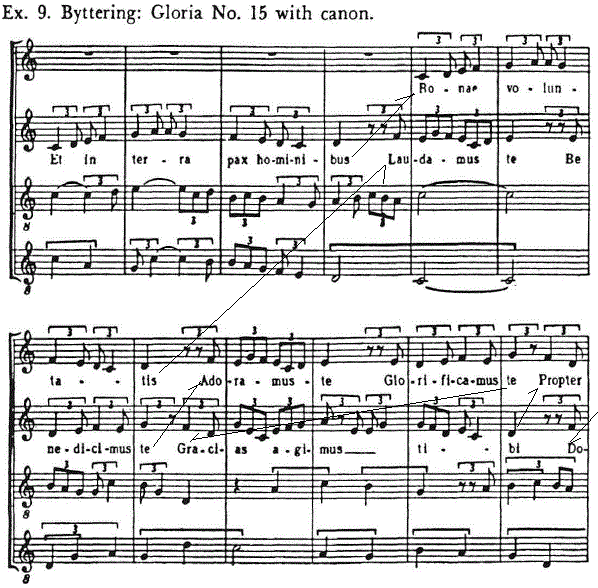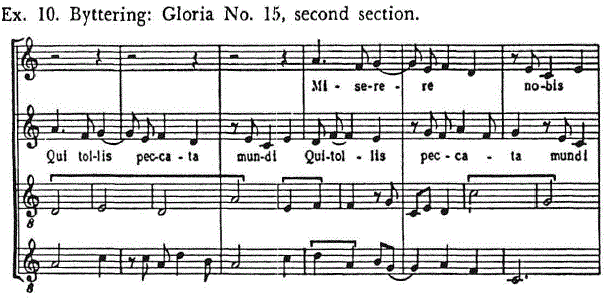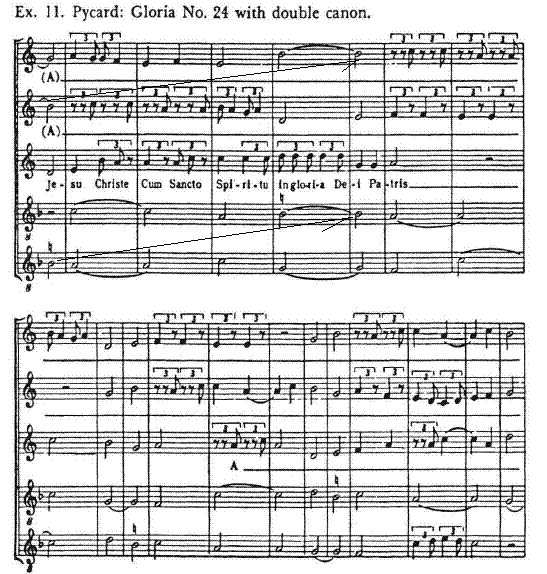| Studies in MEDIEVAL and RENAISSANCE
MUSIC4 |
| Old Hall
Manuscript 5_ THE DATE OF THE MANUSCRIPT The last remarks bring us to the much-debated question of the date of the manuscript. We must distinguish here between two points of time which do not necessarily coincide: when the repertory was composed and when it was actually assembled in the manuscript. The latter date can only be fixed by such extemal features as handwriting,illuminations,et c. These suggest ad ate of c. 1420,bu t it is well known that it is impossible to narrow down strict palaeographical evidence to ap eriod of one or two decades,be cause the scribe may have been old and may therefore have retained the palaeographic characteristics of say,1410,when he was actually writing about 1440 or even later. The date of the repertory can be determined mainly by threefactors: (1)the stylistic internal evidence and compaIUon with parallel sources, (2 ) the type of musical notation employed, (3) historical dates for composers or particular compositions 写本の作成年についての論争について。私達は、必ずしも一致しない2点トをここに区別していなければならない。レパートリーが作曲された時、およびそれらが実際に写本に組み入れられた時である。 後者の日付は、書法や光彩のような外的な特徴で決められる。それによれば、およそ1420年頃であるが、それは10〜20年ほどの幅がある。書記が年を取り、それゆえに1410〜40年といった程度になるためである。 レパートリーの日付は主に、以下のような3つの要素によって決定できる: (1) 平行したソースとの様式的内的証拠と比較 (2 ) 使用された音楽的な記譜法のタイプ、 (3) 作曲者または特定の作品のための歴史の日付 Stylistic evidence is the least precise as far as exact determination of the date is concerned,e specially if an ational school like the English is involved,a s chool that was habitually slow in taking up stylistic innovations and equally slow in abandoning them. On the other hand,s tylistic features can be fairly accurately defined;a nd these furnish most valuable evidence,if not for the exact date,a t least for the period in general and the relative position of English music. 日付の正確な決定に関する限り、様式的証拠は少なくとも正確であり、特に、英国のような一国の楽派となると、様式の革新を取り上げること、およびそれらを捨てることについて、習慣的に遅くなることになる。一方、様式的特徴はかなり正確に定義されうる。そしてこれらは、正確ではなくとも、英国音楽の一般的・相対的地位の期間について、もっとも貴重な証拠を供給する。 The dissonance treatment of which we have repeatedly spoken conforms in the last two motets of the manuscript and in several of the caccia Mass sections to the standards of the aη nova,an d even other compositions,w hich seem to be of somewhat later date and have fewer and less harsh c1ashes,s how that the composers were as yet not concerned about the preparation of dissonances.T he systematic use of prepared dissonances arose in English music in what 1 have called the "panconsonant" style of the generation of Dunstable and Pyamour (d. 1431),w hich cannot be dated before c. 1420-30. The only compositions written in this advanced style are the motets by Dunstable and Forest,b ut these do not belong to the original repertory of OH, as has been pointed out above. Disregarding these additions, we can distinguish six types of composition: (1) conductus settings of Mass sections and antiphons,(2 ) Mass sectiolls in caccia style,(3 ) Mass sections in free treble style,(4 ) Mass sections with group contrasts,(5) isorhythmic Mass sections,and (6) isorhythmic motets proper. 不協和音取り扱いは、写本の最後の2つのモテットおよびars novaの標準に対応するcaccia ミサセクションのいくらかにおいて確認される。そしてその他の作品でさえ、いくぶん後の日付であるように見え、鋭いクラッシュは少なく、作曲家はまだ不協和音に対する用意がなかった。 準備された不協和音のシステマティックな利用は、英国音楽において出現し、それは、Dunstable and Pyamourの世代の”汎協和音”様式と呼ばれるものである。それは1420−30年以前に遡ることはない。 こうした進んだ様式で書かれた唯一の作品は、Dunstable and Forestによるモテットであるが、これらはOHのもともとのレパートリーには含まれていない。 これらの追加分を無視することによって、私達は6タイプの作品を区別できる。 (1)ミサ部門とアンティフォンのコンドゥクトゥス設定 (2 )caccia様式のミサ部門 (3 )自由なtrebleのミサ部門 (4 )グループ化したミサ部門 (5)イソリズムミサ部門 (6)イソリズムモテット固有のもの These types do not by themselves give any de自nitec1ue to the date,for they were probably used side by side by the composers of the Chapel Royal. It should be noted,h owever,th at all of the types were known as early as the late fourteenth century,ョndthe preoccupation with hocket effects to which many compositions of OH attest is also ac haracteristic of the ars nova,be coming obsolete during the first half of the fifteenth century. これらのタイプは自身によって日付への確定した糸口を与えない。なぜならそれらは、チャペルロイヤルの作曲者によって、並んで使われたからである。しかし、そのタイプのすべては14世紀後半であった。そして、OHの多くの作品が主張するホケットの優位性は、15世紀前半には時代遅れになっていたars novaの特徴でもある。 Several types differ fundamentally in respect to rhythm. The majority of the conductus settings make relatively little use of minims; that is to say,the movement proceeds essentially in breves and semibreves with many ligatures,as ag lance at almost any page will disclose (see,for example,the frontispiece to V .lo III). This is the most conservative rhythmic scheme of the OH repertory. The greatest rhythmic complications,with extensive use of minims,occur in the caccia and motet Mass sections,while the ballade Mass sections waver between complex rhythms and evenly progressing motion in tempus terfectum,which became the principal meter in the first half of the fifteenth century. We find analogous Mass compositions of the conductus type in the Apt MS,which has been edited in ar egrettably unreliable manner by Gastoue," and of the isorhythmic type in both the Ivrea and Apt MSS. The repertory of the former belongs to the first half and middle of the fourteenth century,th at of the latter to the last third.T he two sources approximately indicate at what time those types of composition originated in European music. That the Old Hall compositions should be as early as the two Continental manuscript is out of the question,be cause English fourteenth.century music looks quite different. Apt and Ivrea are therefore not strictly parallel but analogous sources to OH. The OH repertory is stylistically not coeval with the ars nova manuscripts but comes later,and for this reason we have used such terms as "archaic" and “conservative." The first two decades of the fifteenth century represent the most probable date at which this conservative attitude could still prevail before the Franco.Flemish innovations took root in England. いくつかのタイプがリズムについて根本的に異なる。コンドゥクトゥス設定の大多数はミニムをほとんど利用しない。すなわち、楽章は本質的に、多くの連結符を伴うbreveとsemibreveにおいて進んでいく。これはOHレパートリーの最も保守的なリズムスキームである。 最も大きいリズムの複雑化は、ミニムの幅広い使用によって、cacciaやモテットミサ部門に出現する。バラードミサ部門は、複雑なリズムとtempus terfectumでの進行の間で揺れていた。それは、15世紀前半の基本的な韻律となった。 我々は、同様のコンドゥクトゥスタイプのミサ曲を、アプト写本に見出す。そして、イソリズムタイプについては、イヴレア、アプト両写本中に見出す。前者のレパートリーは、14世紀の前半〜中期に、後者はその後半1/3に属している。2つの写本は、ヨーロッパの音楽に起源を持った作品のタイプがいつであったかを示している。OH作品が2つの大陸の写本と同期であるだろうということはありえない。なぜなら、英国の14世紀の音楽は、まったく異なっているからである。 OHのレパートリーは、様式的にars nova写本と同時代的ではなく、よりあとの時代のものであり、このために、我々は”古風”とか”保守的”という言葉を使っている。15世紀の最初の20年間は、こうした保守的な態度が15世紀の最初の20年は、フランコ派の革新がイギリスに根ざす前に、こうした保守的な態度がまだ広がることができた最もありそうな日付を表している。 A further point of stylistic evidence is the fact that OH gives as yet no hint of the unified Mass cycle which appears only in the late works of Leonel and Dunstable and which was not fully established before the middle of the century.“Even its earliest manifestation,the pairing of no more than two movemen凶asseen in TuB and BL,is not reflected in the external order of compositions in OH. We have found that certain movements of Gloria and Credo,o r Sanctus and Agnus,were composed possibly in pairs,b ut these are exceptional in OH and by no means very clear. In no case do these pieces have at tenor cantus firmus in common,as do the Masses from such later sources as the Aosta and Trent MSS. The absence of cyclic Masses and the on the whole conservative style of the compositions suggest that OH contains only the works of Leonel's early and middle period. The circumstance,moreover,that a manuscript of such dimensions does not include a single work by Dunstable in the original body of the collection suggests that Dunstable had not yet reached his full stature by the time the manuscript was put together. His possible absence from England would not contradict the argument,because the concordances show a lively give and take between Italy and England. 文体の証拠のより一層のポイントは、OHが、まだ、世紀半ばにはまだ確立していなかったLeonelとダンスタブルの後期作品にだけのみ現れる統一された循環ミサには何ら関与していない、という事実である。その最も早い明示、TuB and BLにおけるの2つの楽章のペアリングでさえ、OHの作品の順序に反映されない。 我々は、Gloria and Credo,or Sanctus and Agnusのある種の楽章が、ペアで作られたがそれはOHにおいては例外であり、はっきりとはしないことに気づいた。どのような場合でも、こうした作品は、一般的に、Aosta and Trent MSSのような後期のソースのように、テノールのcantus firmusを持っている。 循環ミサの不在、および全体的に保守的な作品のスタイルは、OHが、初期、中期のLeonelの作品のみを含んでいることを示している。 こうした次元の写本が、収集物のもともとの形におけるダンスタブルの単独作品を含まない環境は、ダンスタブルが、写本が作られた時までに彼の本来の特徴にまだ到達していないことを示している。イギリスにおける彼の不在は、議論と矛盾していない。なぜなら、イタリアとイギリスの間での調和は、生き生きとしたギブアンドテイクを示すからである。 The type of musical notation in OH corresponds very dosely to that of an umber of late ars nova manuscripts,no tably the Chantilly codex; Paris,Bilbl Nationale,f. ital. 568; Turin,Bibl. Naz. ] II 9;and Modena,Bilbl Estense,lat . 568. They all indulge in deliberately involved mensura1 puzz1es and syncopations,d raw extensively on red notes,and employ specifically the dragma,the semibreve with an upward and downward tail. All these characteristics appear also in the Old Hall notation. The Continental sources can be dated between the last decades of the fourteenth century and the early ones of the fifteenth and thus support a date not later than 1420-30, which applies to Old Hall as well as to the Turin MS,which was written in Cyprus. Both sources stand outside of the centra1 development and represent two late offshoots of the same type of notation. The repertory of the Turin Codex is a! yet untouched by the music of Dufay's generation,w hich gradually abandoned mensural sophistications. OHの音楽記譜法のタイプは、後期ars novaの写本、ことに、Chantilly codex; Paris,Bilbl Nationale,f. ital. 568; Turin,Bibl. Naz. ] II 9;and Modena,Bilbl Estense,lat . 568のそれときわめてよく似ている。それらすべては、意図的に関係する計量記譜法のパズルとシンコペーションに依り、赤い記譜をし、特に、上下の尾を持つsemibreve、dragmaを持っている。 こうしたすべての特徴は、OH記譜法においてもまた、現れる。大陸のソースの日付は、14世紀の最後や15世紀の最初とされる。それゆえ、1420−30年より後であることはなく、トリノ写本同様、OHにもそれは適用される。 両ソースは、中央での発展からは取り残され、同じタイプの記譜法の2つの遅れた枝分かれを表している。トリノ写本のレパートリーは、まだ、円熟した計量記譜を捨て去ったデュファイの世代の音楽の影響を受けない。 Since the publication of the Old Hall MS several new historical dates have come to light,1 arge1y through the research of Mr. ]ohn H. Harvey,w ho very kindly placed his findings at my disposal.“It is generally accepted that Thomas Damett and Nicholas Sturgeon can be identified with the two canons of Windsor active l1430-36 and 1441-54 respectively. It can now be added,th anks to Mr.H arvey,that the last wills of both composers have been found." They were probated in 1437 and 1454 respectively,w hich means that each composer's last year in office was also the last year of his life. If we allow about sixty years as an ordinary life span,w e may assume that they were born c. 1370 and 1390 respectively. We now know that Damett was presented by Henry V to the prebend of Rugmere in St. Paul's Cathedra1 in 1418,a nd Nicho1as Sturgeon received ap ension from the same monarch in 1419・Thesetwo dates are important with regard to the “Henrician" question because they prove irrefutably that the two masters who directly participated in or supervised the compilation of our manuscript were associated with Henry V. OHの出版がされて以来、新たな歴史的日付がMr. ]ohn H. Harveyの研究を通して、もたらされた。Thomas Damett and Nicholas Sturgeonが、それぞれ、1430-36 and 1441-5に活動したウィンザーの2人の惨事会員として特定し得ることが一般的に受け入れられるようになった。 Mr.H arveyのおかげで、両作曲家の最期の意志が明らかになった。彼らは、1437 and 1454にそれぞれ、検認された。両者の礼拝での最期の活動が、両者の最期の年であった。 もし我々が普通の寿命として約60年を許すならば、我々は、彼らは1370および1390年にそれぞれ誕生したと仮定するであろう。 Damettが、1418年に、ヘンリー五世によって、セントポール大聖堂のRugmereの僧禄に紹介されて、Nicholas Sturgeonが1419年に、同じ君主から年金を受け取ったことを、私たちは現在、知っている。こうした日付は、”ヘンリー”問題に関して、重要である。なぜなら、彼らは、「ヘンリー王とは誰かという」ヘンリー五世に関連した巨匠だからである。 Aleyn and Mayshuet have been identified with ]ohannes Alanus and Mayhuet de ]oan of the Chantilly MS,w hich can be dated because of its political references to the late fourteenth century (the extant manuscript is a copy made in the early fifteenth century).The general stylistic similarity between the repertory of Chantilly and OH,re ferred to above,co rroborates the identification,an d,mo reover,there is conclusive evidence that Alanus was English because his motet Sub Arthuro plebs“lists by name numerous English composers about whom next to nothing is known otherwise. Dom Anselm Hughes has tentatively suggested that the Aleyn of OH was the same person as ]ohn Aleyn,c anon of Windsor,who died in 1373. AleynとMayshuetは、 シャンティ写本における]ohannes AlanusとMayhuet de ]oan であると同定されている。それは、政治的関与によって、14世紀の後期であるとされている(現存の写本な、15世紀初頭に作られたコピーである)。 シャンティ写本とOHの間の一般的な様式の類似はすでに記述されたが、Alanusが英国人であった明白な証拠がある。なぜなら、彼のモテットSub Arthuro plebsは、ほとんど何も違った形で知られない名前が多いイギリス作曲者によってリスト化するからである。Dom Anselm Hughes は、OHのAleynが、1373年に死んだウィンザーの惨事会員、 ]ohn Aleynであったことを提案した。 This early date would be out of line with the other dates of OH,and the identification臼nnotin fact be maintained. One of the composers listed in Alanぱmotetis Richard Blithe (or Blich),w ho is known to have been a clerk of the Chapel Royal in 1419. If the canon Aleyn really were the composer,th ere would be ad iscrepancy of at least forty-six years if we assume that the motet was composed shortly before Aleyn's death. This seems rather far-fetched,a nd it is therefore much more Iikely that the composer was still living around 1400. If so,h e could very well be identical with ]ean Alain,who was in the service of the Duke of Lancaster in 1~96. This may be the same ]ohn Aleyn who became Minor Canon at St. Paul's Cathedral in London in 1421叩ddied in 1437・Newdates are available also about ]ohn Pyamour (Piamor),M aster of the Children of the Chapel Royal in 1420. He belonged in 1427 to the retinue of the Duke of Bedfordーitwill be recalled that Dunstable,too,was in the Duke's service-going overseas. Pyamour died in (or before) 1431 , when he is mentioned as deceased. The only extant motet known to be by him is preserved in the Modena MS,Es tense lat. 471,and its style is at least as advanced as that of Forest's motet Qualis est dilectus. I include these references here because they pennit us to date the advanced,p anconsonant style of English music c. 1430 at the latest. This style appears in OH only in the pieces that were added by hand; the main repertory belongs to the preceding phase of English music. この早い日付は、OHの他の日付とはかけ離れている。そして、同定は維持され得ない。Alanusのモテットにリスト化された作曲家のひとりはRichard Blitheであり、彼は、1419年に王室礼拝堂チャペルの執事として知られている。もし惨事会員Aleynが本当に作曲者であったならば、もし我々が、Aleynの死の前にまもなくモテットが創作されたと仮定するならば、少なくとも46年の矛盾があることになる。これがむしろありそうもない。そして作曲者は約1400年頃には、生きていたことはありえそうであった。もしそうなら、彼は]ean Alainと同一であるかもしれない。 1421年にロンドンのセントポール大聖堂のMinorCanonであった]ohn Aleynと同一であるかもしれない。 新たな日付は、1420年の王室礼拝堂のMaster of the Childrenであった]ohn Pyamourについても当てはまる。彼は、ダンスタブルもデュークのサービス海外に行きの時にであったBedfordのデュークの随員に1427年に属していた。Pyamourは1431年かそれより前にに死んだ。彼の作であると知られている唯一の現存のモテットは、モデナMS、Es tense lat. 471に保存されている。その様式は、少なくとも、そのスタイルはForestのモテットQualis est dilectusのそれと同じくらい少なくとも高度である。私はここでのこうした言及を盛り込む。なぜならそれらは、少なくとも1430年頃の、進んだ英国音楽の汎協和音様式を我々に許容するからである。こうした様式は、手書きで追加されたOHの作品においてのみ見られる。主たるレパートリーは、英国音楽の先行した局面に属している。 It is noteworthy that Pyamour,who definitely belonged to the Chapel Ro y,lais not included in the manuscript,wh ile Leonel,who appears here more frequently than any other composer,has no traceable connection with Windsor. However,it would be wrong to assume that aIl composers of the ChapeI Royal were associated with St. George's Chapel at Windsor Castle. Mr. Harvey has pointed out to me that music historians since Barclay Squire have confused the general institution of the Chapel Royal,w hich was not fixed to any one place,with the particular one at Windsor. The repertory of OH is not restricted to composers active in Windsor. Leonelはその他の作曲家よりもしばしばOH写本に含まれ、ウィンザーとの関係が見られないが、Pyamourは明らかに王室礼拝堂に属しており、写本に含まれていないことは注目すべきである。しかし、王室礼拝堂でのあらゆる作曲家がウィンザー宮での聖ジョージ礼拝堂と関連した、と仮定べきではない。Mr. Harveは、私に、Barclay Squire以来の音楽歴史家が、王室礼拝堂の一般的団体を混同したのを指摘した。王室礼拝堂は、特定の場所に固定されておらず、ウィンザーと特殊な関係があったわけではなかった。OHのレパートリーは、ウィンザーで活躍した作曲者に限定されない。 Certain composers have not yet been definitely identified. There is a record of one john Forrest who held a prebend in Lincoln Cathedral in 1394,became archdeacon of Surrey in 1414,D ean of Wells in 1425,and died in 1446. john Tyes of the manuscript may be identical with john Dyes,o rganist of Winchester in 1402,as has been pointed out by Dom Anselm Hughes.There were at least two clerks in the Chapel Royal by the name of john Cooke,o ne who is mentioned in 1414 and 1417,a nd who died in 1419,a nd another who received grants in 1430,1 440,a nd 1455. According to Dom Anselm Hughes there are also references in the Windsor archive to Rowland,Robert Cherbury, and Pycard in 1454. 1455,a nd 1461 respectively. but he stresses the fact that we have no proof of sure identification,a nd the last date especially is highly improbable in view oE Pycard's close adherence to arsηova style・“ Adate of great importance is the death of Leonel Power on june 5・1445..0 This places the leading composer of the Old Hall MS somewhat before Dunstable's mature phase. which seems very likely from the stylistic point of view also. as 1 have suggested elsewhere. 何人かの作曲家はまだ、明確に同定されていない。1394年のリンカーン大聖堂の僧禄を保持した1人のJohn Forrest の記録があり、1414年、Surreyの大執事となり、1425年にWellsのDeanとなり、1446年に死んだ。写本中のJohn Tyesは、Dom Anselm Hughesによってしてきされてように、1402年にウィンチェスターのorganistであったJohn Dyesと同一であろう。John Cooke という名の執事がチャペルロイヤルに少なくとも2人いた。 Dom Anselm Hughesによると、Windsor archiveには、Rowland,R obert Cherbury.Pycard の名がそれぞれ1454. 1455,1461年に記されている。しかしそうした同定には特に証拠はない、と彼は主張しており、最後の年は特に、Pycardのars nova様式への固執への観点からすれば、非常に考えにくい。 もっとも重要な日付は、L.Powerが死んだ1445年7月5日である。この日付は、ダンスタブルの成熟期よりは幾分前であり、OHの主要な作曲家が活躍した時期である。(以下略)。 6. A POSTSCRIPT Old Hall写本の日付に関する論争の勃興とともに、一般的状況が関連してくる。こうした点から参考になるのは、大陸の写本との一致性である。それらは、OHのレパートリーが、むしろ幅広く拡大したことを示している。そして、写本自身が少なくともひとつの付加的な大陸期限の作品を含んでいる。より重要なことは、ヨーロッパ大陸から英国へと移ったL.Powerに関する写本の日付についてである。 OH写本は、ミサ通常文に属するテキスト設定の5つのカノン設定を含んでいる(Pycardによる3つのGloria(I 76,84,119,作者不詳の2つのCredo(II 82,101 No.75 fol. 62v-63, ))。これらの作品のうちの1つを除く全部でのカノンの解決のために、写本自身が明示的なラテン語の指示を出している。1つ(II 82 No.71fol. 59v-60)において(訳注;現在ではPycard作となっている)は、カノン書法が含まれている直接の示唆はないが、写本に見つかる3声を実際化する試みには、間違いなく、いくつかの欠落がある。 Mr. H. B. Collinは、この作品のはっきりとした解決法を示している。つまり、2つの伴奏声部と3声のカノンとしてである。彼は、作品内のいくつかの点で、書かれたcantus声部が2つの言葉をセットで持っていることに注目している。-at Genitum non factum the second set begins with Qui propter nos,while Et in Spiritum is similarly combined with Qui cum Patre,and Confiteor with Et exspecto. Collins adapts the upper lines of text to the voice beginning the canon and to the first of the two voices that follow it,leaving the lower lines to the second of the consequent voices 彼の校訂においては、Collinsは、テキストの上の行を、カノンの始まりの声部とし、2声のうちの最初とし、下の行を、続く声部としている。実際、結果的には、Gloriaと Credoのtelescope設定とほとんど異なることはない。 Mr. H. B. Collinや作者不明のCredoにおける二重の歌詞設定についての彼の言及のおかげで、OH写本のカノン設定のリストに新しい項目を加えることや、すでにこのリストにあるような別の項目が、写本中に示されているが二重ではなく示されている単純なカノンではないことを示すことは、困難ではなくなっている。なぜなら、telescopeされた二重のテキストを持つ単一の声部が、カノン書法の存在の間接的指示であることが認識され、驚くべきことには、明らかな結論は、ずっと前から描かれていなかった。 問題の2つの作品の最初は、Gloria by Byttering(I,47No.18 Gloria(fol. 14v))である。それは、Barclay Squire'のリストでは、No.15 になる。この作品は、声楽のcantusと器楽のtenor,contoratenorの3声の書かれた声部からなっている。ここでは、telescopeされた二重のテキストは、cantus声部の最初の小節から最後まで途切れることがなく続いている。上の行は続く終止の最初となり、下の行は最後となる。 この作品が非特異的なカノンであると、解決は、最初のセクションにおいて、続く声部は4小節後にユニゾンで入ってくることになる(Ex.9)。  連続的な声部は、写本におけるものと完全に一致するだけでなく、多くの三和音における五度や三度をも提供する。3声のみにおいては、tenor and contratenorの第5,6小節における突然の終止形は、不器用なあり方であるが、4声では、それはよく考慮された洗練さを持っている。4番目の声部なしでこの作品が何らセンスがないと言うは、何ら誇張ではない(隠されたカノンを使ってこそ、この曲は生きる)。 Byttering's Gloria (tempus perfectum,with the contratenor in tempus imperfectum at the beginning)の第2セクションにおいて、連続声部の入りは、やはりユニゾンで始まる。nice strokeは、この最後のセクションにおいて、4小節から3小節への時価減少となる(Ex. 10)。  Bytteringの小作品の特別な魅力は、よく計画された歌詞と音楽との協調である。カノン構造の結果として、第1セクションは4小節で、第2セクションは3小節単位となる。前後の間の典礼歌詞を分けるにあたり、Bytteringはこの全体的な周期化に従い、その結果、それぞれの長さにおいて、連続する声部は、ちょうど歌われた音符と共鳴しながら、先行する声部によって残された終止を作り上げる。先行する声部は同時に、あとにくる終止の最初を始めている。 その結果、Gloriaのテキストのカノン的な特徴は、父と子をアピールする同時的なデクラマシオンとなる。続く声部はDeus Pater omniPotensを歌い、すでに聴かれたDomine Deus Rex caelestisと共鳴する。先行する声部はすでに、Domine Fili unigeniteを歌い始めている。同時に、Domine Deus,Agnus Dei,and Jesu Christeが聴かれる。 telescopeされた二重のテキストを伴う声部は、潜在的なカノンの先行であり、OH写本のGloriaの間でのもうひとつの声部との出会いであると、我々は仮定すべきである。Gloria(I 84 No.27fol. 22v-23 )の作曲者はPycardであり、我々は、彼に関してはすでにその他の2つのカノン的Gloriaを指摘している(I 76 no.26 fol. 21v-22,119 No.35 fol. 29v-30)。 これらは2声部を持ち、一方(I 119 No.35 fol. 29v-30)は、一重の歌詞と二重の歌詞とが交互となってtelescopeされている。もう一方は、通常の形式における完全な歌詞を持っている。 これらの声部に伴って、器楽のテノールの指示が出されている。Tenor et contratenor in uno,unus post alium fugando quinque temporibus 写本は"solus tenor"を持っている。それは、声部の数を減らすことが必要であれば、カノン的なテノール、コントラテノールの代替となっている。 現状では、作品は4声のためのものとされている("solus tenor"が使われれば、3声)。しかし、下記のような1つのcantus声部においてtelescopeされたテキストは、それが実際には5声のためのものであったことを示している。そして、テノールの規則のcantusへの適用の試みがこれを確信する。Ex. 11(No.27 Gloria(fol. 22v-23)p84)において(”Amen”を含めて5小節周期)、代替する"solus tenor"は省略されている。  As in the Gloria by Byttering,the added consequent voice fills out a number of incomplete triads.What is more striking,it also completes the hockets: the construction of the antecedent voice,which sings alternately after and on the beat in the corresponding measures of the successive five-measure periods,is now seen to be a deliberate and ingenious calculation. BytteringのGloria のように、付加された連続する声部は、不完全な三和音を満たしている。より重要なことは、ホケットを形成することである。先行する声部の形成は、連続する5小節の区切りに相当する小節内で、交互に歌っており、熟考された天才的な計算のように見える。 Once again the piece becomes fully intelligible only when the unspecified canon is resolved; it is this canon that is the truly essential one-not the specified canon of tenor and contratenor,whose omission the composer expressly sanctions. 再度、特定されていなかったカノンが解決されたときに限り、作品は完全に理解される。 それは本当に本質的なものであり、テノールとコントラテノールの特定されたカノンではなく、作曲者が明示的に認可を行うのはこのカノンである。 Pycardのカノン的Gloriaは、疑いなく、デュファイの有名なGloria ad modum tubaeよりもかなり早期のものであり、ジョスカンやオケゲム以前の時代の非常に珍しい多重カノンの例である。 Dufay Gloria ad modum tubae 楽譜 Surely it is significant that of the six canonic pieces in the Old Hall MS four are Glorias,while only two are Credos. Throughout the earlier fifteenth century the Gloria text is the preferred text for canonic treatment: we have no Credos to offset the canonic Glorias of Modena 568, of Arnold and Hugo de Lantins, of Trent 925 and 927,of Dufay. It is also significant that of the six canonic pieces in the Old Hall MS only the two Credos involve three-part canonic writing. For their time,these six pieces constitute the largest known group of their kind. And they follow too closely on the heels of the pair in Modena 568 to justify the assumption of a direct borrowing from Italy; it is at least equally possible that the application of the canonic principle to the Ordinary of the Mass began independently and more or less simultaneously on both sides of the Channel. 確かに、Old Hall MSの6つのカノン作品のうち、4つはグロリアであり、2つだけがクレドである。 15世紀初期を通して、グロリアのテキストは、カノンの取り扱いのために適したテキストとなっている。DufayについてのTrent 925と927、ArnoldとHugo de Lantins、Modena 568のカノン的 Gloriaを埋め合わせるようなCredoはない。 オールドホール写本の6つのカノン作品の中でも重要なのは、2つのクレドだけが3声のカノン書法を含んでいることである。 この時代、これらの6つの作品は、知られているこの種の作品のうちで、最大のグループを構成している。 それらは、イタリアからの直接の導入の前提を正当化するために、Modena 568のペアのheelに非常に緊密に従っている。 カノンの原則をミサ通常文に適用することが、ドーバー海峡の両側で独立して、あるいは多かれ少なかれ同時に始まったことは、少なくとも同じように可能である。 |